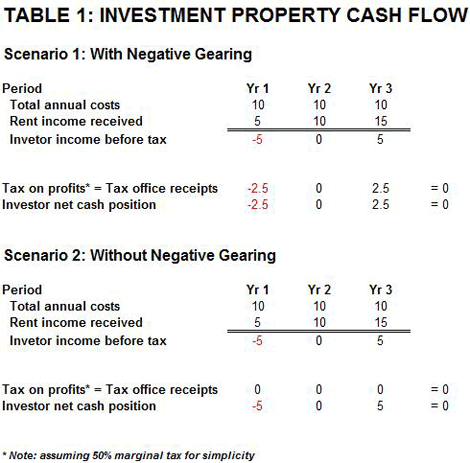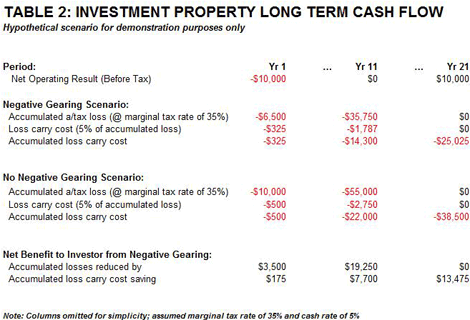Negative gearing: The three facts that will challenge your assumptions
Negative gearing is a topic that brings out heightened emotions during discussions since opinions about it tend to be very polarized – either strongly critical or overly enthusiastic. However, there is very little academic research on the effects of negative gearing, hence there is lack of indisputable evidence in support of either point of view.
Commentators criticising negative gearing just assume that since there is a tax deduction involved, the whole scheme must be “a tax rort, benefiting rich and driving property prices to extreme levels”. The opposite side argues that without negative gearing “property investors would lose interest in buying properties for rental accommodation”, or even “sell what they currently own”, which will inevitably “lead to hikes in the cost of renting”.
Let’s explore a few basic but very little understood facts about negative gearing to put those views into perspective. These facts challenge common wisdom about negative gearing. The intention here is not to take sides but rather to highlight the need for proper research, so the impacts of negative gearing on the property market in Australia can be properly assessed - for long term tax and social policy purposes as well as for investment decisions by individuals. If that research is not undertaken, the risk is that, without the proper understanding of the implications, important and far reaching decisions will be made based on totally incorrect assumptions and therefore anticipated outcomes will not materialise.
Fact one: Negative gearing benefits investors with fewer economic resources more than the rich
One benefit of negative gearing is that it reduces the amount of accumulated losses in the initial years of the investment and therefore it lowers the costs of carrying those losses for the investor. It leads directly to the second benefit, a benefit with an important social dimension: negative gearing allows people with fewer economic resources to participate in this class of investment.
In particular, it is often overlooked that a property investor has to have a capacity to carry real cash losses for several years. That is, in the first few years of the investment those losses accumulate and then are gradually reduced by profits generated in subsequent years. Negative gearing reduces the total amount of accumulated loses by as much as 30-40% (equivalent to the taxpayer marginal tax rate). True, rich investors benefit from this reduction as well but they have a better capacity to fund such loses. Therefore, the benefit of negative gearing goes directly to those less fortunate, who may not have the financial resources to carry higher losses if negative gearing is not allowed.
Whether property investment by a wider community should be actively encouraged through lowering barriers to entry is a topic for a separate debate however, the fact is that negative gearing benefits investors with lower incomes more than the rich. One could even risk a thesis that removal of negative gearing could be to a great advantage of the rich because the pool of potential property investors would be reduced. However, it does not necessarily equate to falling prices – rather, that investment properties would be concentrated in fewer hands over time. This and similar not totally impossible scenarios should be given a serious consideration and should be research in depth before drawing hasty conclusions.
Next page: Negative gearing and tax payments
Fact two: Negative gearing alters timing of tax payments but not the overall amount of tax paid by investors and received by the tax office.
In case you wonder, yes you read it correctly – negative gearing is tax neutral for investors and the tax office. There is a very simple explanation for this. You often hear "negative gearing" and "tax saving" mentioned in one sentence so it is easy to jump to a conclusion that one equals the other. However, the reality is that there is “no tax saving” for property investors or “cost to taxpayers” if property is held over many years – through loss making years until it starts generating profit in the later years.
Let’s consider a couple of scenarios, mind you very simplified, for the purpose of explaining this concept:

In both scenarios, investor’s net after tax cash position at the end of year three equals $0 (then profit year after year from rent plus bonus from any capital gain - which is taxable on sale of the property). Similarly, net tax paid to the government is the same under both scenarios (ie. case one: -2.5+0+2.5=0; case two: 0+0+0=0). Thereafter, the same amount under both scenarios. The only thing that is different under each scenario is timing of tax payments. That is, under negative gearing scenario tax office takings are reduced by 2.5 in year one (as investor offsets loss against other income) then increased by 2.5 in year three. Under no negative gearing scenario, tax office will not receive any tax payments until year four.
The above example clearly demonstrates that negative gearing affects only cash flow of the investor and the tax office and not the overall amount of tax paid or received over time. It is simply because under the negative gearing scenario investors can claim rental losses against other income streams in early, loss making years but it also means they have to start paying tax on profits much earlier than would be the case under no negative gearing scenario, since there are no accumulated losses from previous years to claim against. Therefore, negative gearing is not a tax rort and it doesn’t mean that taxpayers “subsidise speculators”.
For the completeness of information, it has to be acknowledged that, under the negative gearing scenario, if marginal tax rate of an investor changes over time (that is, either increases due to career advancement or government increasing taxes, or decreases due to reduced income or government lowering taxes) there will be some discrepancy in the amounts of tax deductions claimed in the initial phase of the investment and tax paid in the future years. This simplified analysis also does not take into account the fact that “a thousand” dollars now is worth more than a thousand dollars in 10 years time. However, in aggregate, the differences will be relatively insignificant.
Another point worth mentioning is that there will be cases of investors liquidating their property holdings while still within the loss making period. This can happen for a variety of reasons but generally, there is no incentive for investors to "cash in" very often just to "save on tax" due to significant cost of transactions (buying and selling). There would have to be a very substantial capital appreciation of the property to cover from net sales proceeds all those expenses as well as net loses carried from previous years and capital gain tax. So, such cases are exceptions rather than the norm.
Next page: Looking at the financial benefit of negative gearing
Fact 3: Financial benefit of negative gearing is minimal
As demonstrated in the previous section, negative gearing does not "save tax" for investors however, it is not to say that it does not deliver any tangible benefits. The primary benefit is that negative gearing reduces the amount of accumulated losses carried forward in the initial years of the investments.
Since there is a cost of carrying a loss from year to year (equal to interest payment on the cumulated amount), the financial benefit of negative gearing equals the value of savings in interest payments. That is, the cost that the investor does not have to incur. It will become obvious once we examine the following simple example:

In this hypothetical scenario we start with a property generating $10,000 loss in year one of the investment (a typical loss reported to ATO) and that loss reduces by $1,000 a year. Break even on this investment is achieved in year 11 and property generates surplus income in subsequent years (increasing by $1,000 a year).
The key point to note is that in this scenario accumulated loses (that is, the real cash that the investor has to outlay in addition to the initial purchase price to hold the property) peak at $55,000 under no negative gearing scenario and only at $35,750 under the negative gearing scenario. A difference of $19,250 - which equates to real cash saving in non-tax deductible interest payments of $13,475 over 21 years (assuming prevailing interest rate on cash of 5%). Higher interest rates over the period will increase the amount of saving but overall, the amount is relatively insignificant in relation to the original purchase price of the investment property.
This conclusion has far reaching implications. Firstly, since there is no tax saving and the true financial benefit is relatively insignificant, it puts in question a common assumption that negative gearing encourages investors to bid higher prices for properties purchased for investment purposes. True, there may be psychological factors (e.g. based on a false belief that "saving on tax" is possible) that encourage some investors to bid higher prices but nobody really knows how much it is, if at all – is it 1%, 5%, 10%? More studies on this issue are required but clearly, there is not much incentive for informed investors to pay against the odds for the property.
The second important implication is that negative gearing has in effect very little impact on the returns. If this fact was widely known by current property investors there should be no panic-selling of investment properties if, at some stage, negative gearing comes under the threat of removal. And, as the result, there should be no impact on rental prices in the short term either.
This article presented three important but mostly unknown facts about negative gearing. These facts challenge common wisdom. They clearly demonstrate that negative gearing is not a cost to taxpayers, that its impact on property prices is mostly negligible, that negative gearing benefits lower income earners more than the rich and that, if it is abolished, there is no reason for panic-selling of investment properties or altering the approach to property investment.
The intention here is not to judge whether negative gearing is good or bad, or whether it should or should not be retained, but rather to highlight that there is more to negative gearing than just what attention grabbing headlines may imply. We need more academic research into the issue and better education about the true implications of negative gearing so any further debates and decisions (personal as well as those concerning social and economic policies) can be based on facts and not merely on possibly well intended but rather misguided opinions.
Arek Drozda is an independent analyst who has worked in the public and private sectors for over 20 years in business development, data analysis and in building geographic information systems.